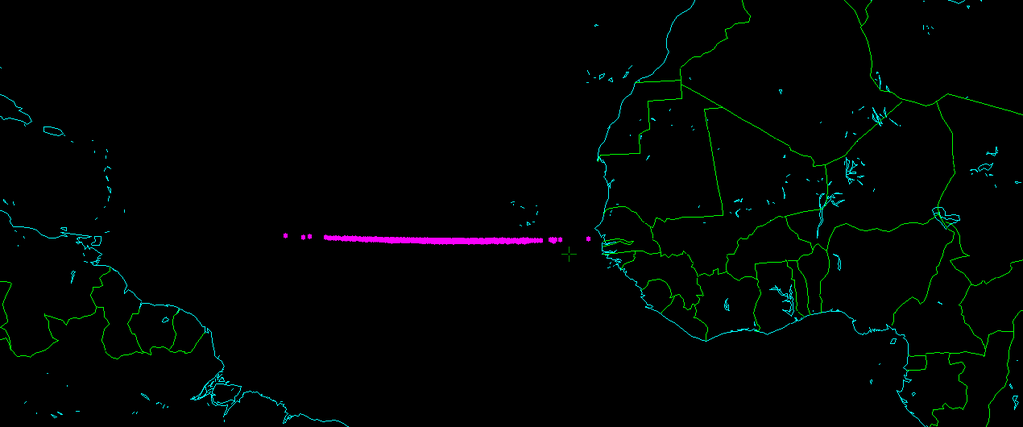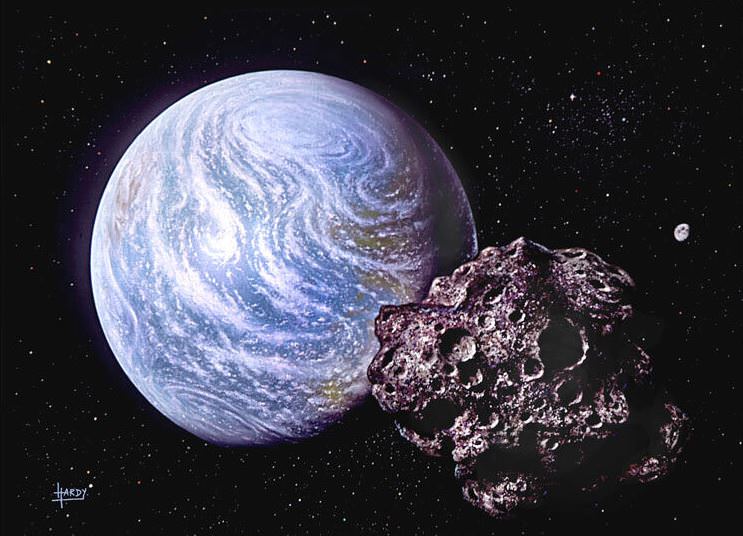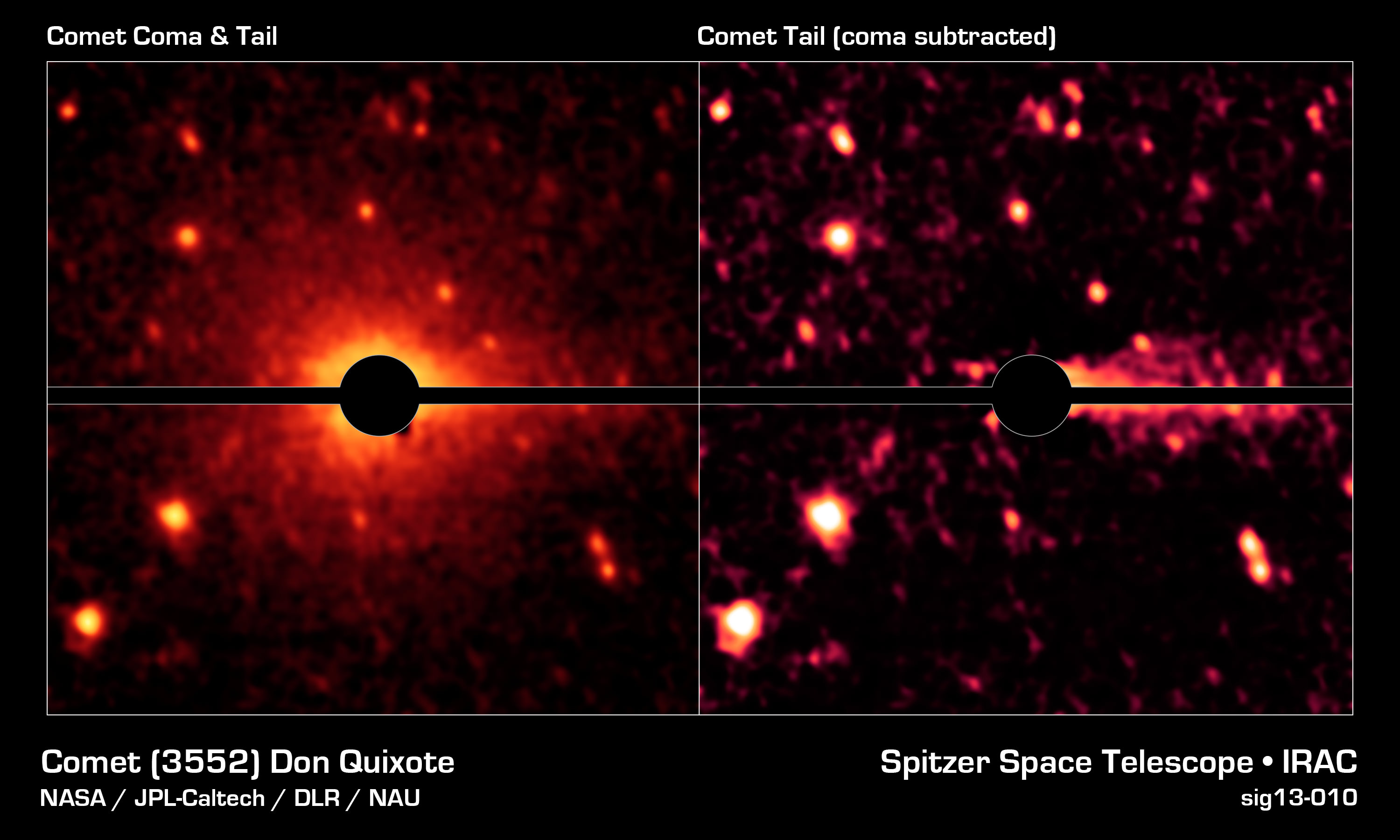Host: Fraser Cain
Guests: Emily Lakdawalla, David Dickinson, Jason Major, Brian Koberlein, Brian Wang
Continue reading “Weekly Space Hangout – January 3, 2014: Quadrantids & What’s Coming in 2014”
Three-Meter Asteroid Hits Earth’s Atmosphere… Somewhere
This was very likely the last trip around the Sun for the Earth-crossing asteroid 2014 AA, according to calculations by several teams of astronomers and published online earlier today on the IAU’s Minor Planet Center. Discovered just yesterday by the Catalina Sky Survey, the estimated 3-meter-wide Apollo asteroid was supposed to clear Earth today by a razor-thin margin of about 611 km (380 miles)… but it’s now looking like it didn’t quite make it.
The diagram above, via Asteroid Initiatives’ Twitter feed, shows a projected path probability pattern for 2014 AA’s re-entry locations. No eyewitness accounts have yet been reported, and if anyone knows of any surveillance cameras aimed in those directions that might have captured footage of a bolide feel free to share that info below in the comments and/or with @AsteroidEnergy on Twitter.
Other calculations put the entry point anywhere between western Africa and Central America.
According to the MPEC report the asteroid “was unlikely to have survived atmospheric entry intact.”
Watch an animation below showing 2014 AA’s point-of-view as it met Earth. (Video courtesy of Pasquale Tricarico, senior scientist at the Planetary Science Institute in Tucson, AZ.)
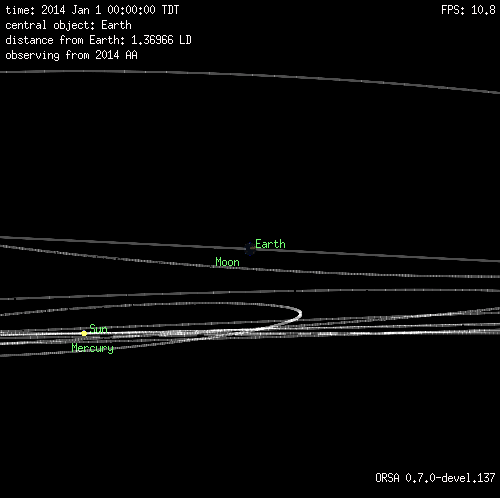
JPL’s Near-Earth Object program classifies Apollo asteroids as “Earth-crossing NEAs with semi-major axes larger than Earth’s (named after asteroid 1862 Apollo).” And while not an Earth-shattering event (fortunately!) this is just another small reminder of why we need to keep watch on the sometimes-occupied path our planet takes around the Sun!
Read the NASA/JPL news release on 2014 AA here.
h/t to Dr. John Barentine for the heads-up!
UPDATE: Based on infrasound analysis by Peter Brown of the University of Western Ontario, 2014 AA likely impacted the atmosphere over the Atlantic around 0300 UTC at 40° west, 12° north — about 1,900 miles east of Caracas, Venezuela. The impact released the equivalent of 500 to 1,000 tons (0.5 – 1 kiloton) of TNT, but far above a remote and uninhabited area. Read more on Sky & Telescope here.
Japanese ‘Space Cannon’ On Track For Aiming At An Asteroid: Reports
Watch out, asteroid 1999 JU3: you’re being targeted. As several media reports reminded us, the Japan Aerospace Exploration Agency (JAXA)’s Hayabusa-2 asteroid exploration mission will carry a ‘space cannon’ on board — media-speak for the “collision device” that will create an artificial crater on the asteroid’s surface.
“An artificial crater that can be created by the device is expected to be a small one with a few meters in diameter, but still, by acquiring samples from the surface that is exposed by a collision, we can get fresh samples that are less weathered by the space environment or heat,” JAXA states on its website.
Reports indicate JAXA is on schedule to, er, shoot this thing into space for a 2018 rendezvous with an asteroid. The spacecraft will stick around the asteroid for about a year before heading back to Earth in 2020. The overall aim is to learn more about the origin of the solar system by looking at a C-type asteroid, considered to be a “primordial body” that gives us clues as to the early solar system’s makeup.
Check out more on Hayabusa-2 on JAXA’s website.
“Oddball” Asteroid is Really a Comet
It’s a case of mistaken identity: a near-Earth asteroid with a peculiar orbit turns out not to be an asteroid at all, but a comet… and not some Sun-dried burnt-out briquette either but an actual active comet containing rock and dust as well as CO2 and water ice. The discovery not only realizes the true nature of one particular NEO but could also shed new light on the origins of water here on Earth.
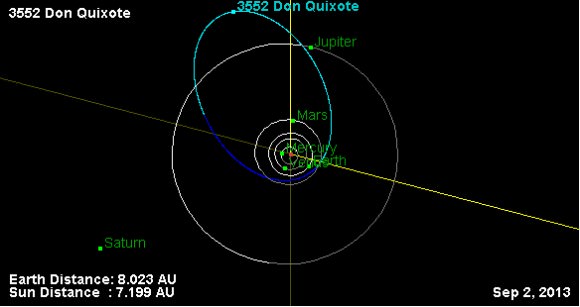
Designated 3552 Don Quixote, the 19-km-wide object is the third largest near-Earth object — mostly rocky asteroids that orbit the Sun in the vicinity of Earth.
According to the IAU, an asteroid is coined a near-Earth object (NEO) when its trajectory brings it within 1.3 AU from the Sun and within 0.3 AU of Earth’s orbit.
About 5 percent of near-Earth asteroids are thought to actually be dead comets. Today an international team including Joshua Emery, assistant professor of earth and planetary sciences at the University of Tennessee, have announced that Don Quixote is neither.
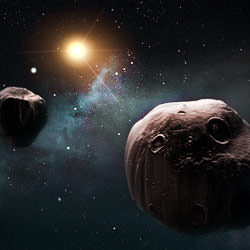
“Don Quixote has always been recognized as an oddball,” said Emery. “Its orbit brings it close to Earth, but also takes it way out past Jupiter. Such a vast orbit is similar to a comet’s, not an asteroid’s, which tend to be more circular — so people thought it was one that had shed all its ice deposits.”
Read more: 3552 Don Quixote… Leaving Our Solar System?
Using the NASA/JPL Spitzer Space Telescope, the team — led by Michael Mommert of Northern Arizona University — reexamined images of Don Quixote from 2009 when it was at perihelion and found it had a coma and a faint tail.
Emery also reexamined images from 2004, when Quixote was at its farthest distance from the Sun, and determined that the surface is composed of silicate dust, which is similar to comet dust. He also determined that Don Quixote did not have a coma or tail at this distance, which is common for comets because they need the sun’s radiation to form the coma and the sun’s charged particles to form the tail.
The researchers also confirmed Don Quixote’s size and the low, comet-like reflectivity of its surface.
“The power of the Spitzer telescope allowed us to spot the coma and tail, which was not possible using optical telescopes on the ground,” said Emery. “We now think this body contains a lot of ice, including carbon dioxide and/or carbon monoxide ice, rather than just being rocky.”
This discovery implies that carbon dioxide and water ice might be present within other near-Earth asteroids and may also have implications for the origins of water on Earth, as comets are thought to be the source of at least some of it.
The amount of water on Don Quixote is estimated to be about 100 billion tons — roughly the same amount in Lake Tahoe.
“Our observations clearly show the presence of a coma and a tail which we identify as molecular line emission from CO2 and thermal emission from dust. Our discovery indicates that more NEOs may harbor volatiles than previously expected.”
– Mommert et al., “Cometary Activity in Near–Earth Asteroid (3552) Don Quixote “
The findings were presented Sept. 10 at the European Planetary Science Congress 2013 in London.
Source: University of Tennessee press release
__________________
3552 Quixote isn’t the only asteroid found to exhibit comet-like behavior either — check out Elizabeth Howell’s recent article, “Asteroid vs. Comet: What the Heck is 3200 Phaethon?” for a look at another NEA with cometary aspirations.
How Can We Stop An Asteroid?
“It’s like looking for a charcoal briquette in the dark,” says Bill Nye the Science Guy in this new video from AsapSCIENCE… except he’s talking about briquettes hundreds of meters wide whizzing past our planet upwards of 8, 9, 10, even 20 kilometers per second — and much, much denser than charcoal.
Near-Earth asteroids are out there (and on occasion they even come in here) and, as the planet’s only technologically advanced spacefaring species, you could say the onus is on us to prevent a major asteroid impact from occurring, if at all possible — whether to avoid damage in a populated area or the next mass extinction event. But how can we even find all these sooty space rocks and, once we do, what can be done to stop any headed our way?
Watch the video (and then when you’re done, go visit the B612 Foundation’s Sentinel page to learn more about an upcoming mission to bag some of those space briquettes.)
‘Avalanche’ Risk Higher Than Thought For Asteroid Landings: Study
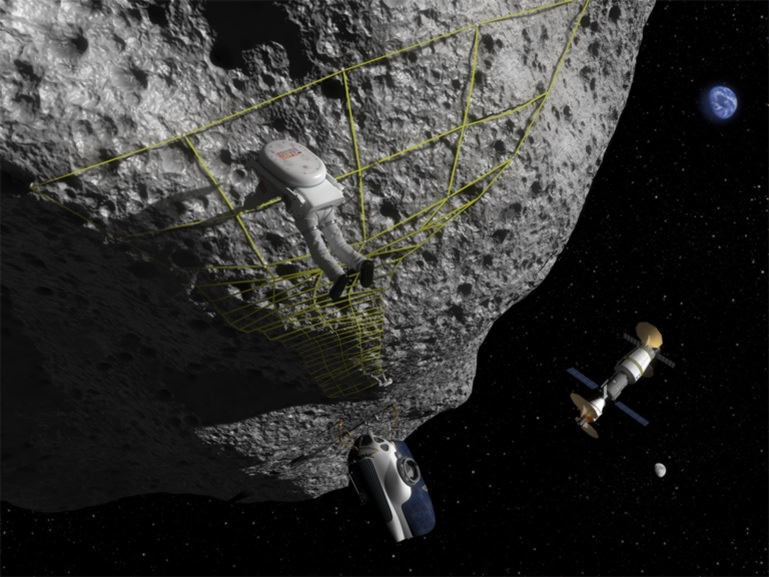
Imagine plunking your spacecraft down on an asteroid. The gravity would be small. The surface would be uneven. The space rock might be noticeably spinning, complicating your maneuvering.
Humans have done it with robotic spacecraft before. The first time was in 2001, when NASA made a stunning landing with the NEAR Shoemaker spacecraft on Eros — using a craft that was not even designed to reach the surface. A new study, however, portrays getting close to these space rocks as perhaps even more hazardous than previously thought.
An experiment done aboard a “Vomit-Comet” like airplane, which simulates weightlessness, suggests that dust particles on comets and asteroids may be able to feel changes in their respective positions across far larger distances than on Earth.
“We see examples of force-chains everywhere. When you pick an orange from a pile in a supermarket, some come away easily, but others bring the whole lot crashing down. Those weight-bearing oranges are part of a force-chain in the pile,” stated Naomi Murdoch, a researcher at the Higher Institute of Aeronautics and Space (Institut Supérieur de l’Aéronautique et de l’Espace) in Toulouse, France.
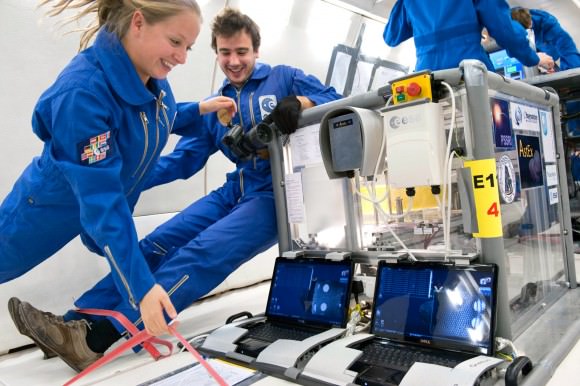
“One important aspect of such chains is that they give a granular material a ‘memory’ of forces that they have been exposed to. Reversing the direction of a force can effectively break the chain, making the pile less stable.”
The Asteroid Experiment Parabolic Flight Experiment (AstEx) experiment was designed by Murdoch, Open University’s Ben Rozitis, and several collaborators from The Open University, the Côte d’Azur Observatory and the University of Maryland. It had a cylinder with glass beads inside of it, as well as a rotating drum at the heart.
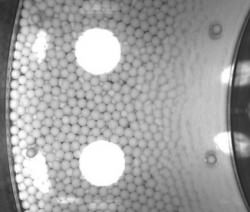
In 2009, when they were postgraduate students, Murdoch and Rozitis took their contraption on board an Airbus A300, which flew parabolas to simulate microgravity while the aircraft falls from its greatest height.
During this time, the inner drum spun up for 10 seconds and then the rotational direction was reversed. What happened was tracked by high-speed cameras. Later, the researchers analyzed the movement of the beads with a particle-tracking program.
The researchers found that particles at the edge of the cylinder (the closest analog to low-gravity environments) moved more than those in similar environments on Earth. Those closer to the center, however, were not as greatly affected.
“A lander touching down on the surface on one side of a small, rubble-pile asteroid could perhaps cause an avalanche on the other side, by long-range transmission of forces through chains It would, however, depend on the angle and location of the impact, as well as the history of the surface – what kind of memories the regolith holds,” said Murdoch.
Check out more details of the experiment in the June 2013 issue of the Monthly Notices of the Royal Astronomical Society. It’s some interesting food for thought as NASA ponders an asteroid retrieval mission that so far has met with skeptical Congress representatives.
Source: Royal Astronomical Society
Earth-Passing Asteroid is “An Entirely New Beast”
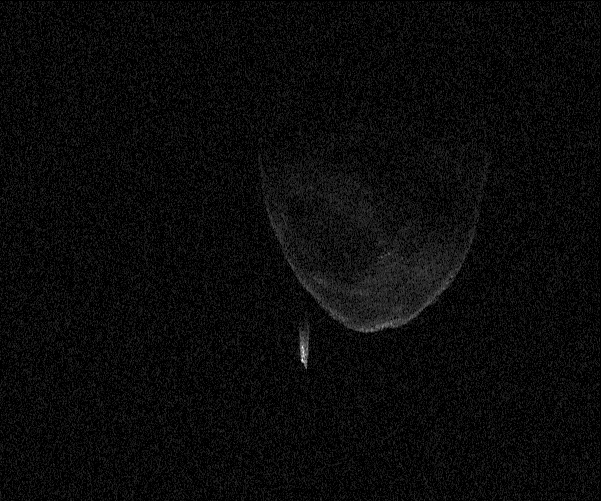
On the last day of May 2013 asteroid 1998 QE2 passed relatively closely by our planet, coming within 6 million kilometers… about 15 times the distance to the Moon. While there was never any chance of an impact by the 3 km-wide asteroid and its surprise 750 meter satellite, astronomers didn’t miss out on the chance to observe the visiting duo as they soared past as it was a prime opportunity to learn more about two unfamiliar members of the Solar System.
By bouncing radar waves off 1998 QE2 from the giant dish at the Arecibo Observatory in Puerto Rico, researchers were able to construct visible images of the asteroid and its ocean-liner-sized moon, as well as obtain spectrum data from NASA’s infrared telescope in Hawaii. What they discovered was quite surprising: QE2 is nothing like any asteroid ever seen near Earth.
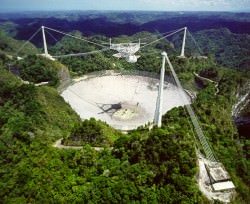
Both Arecibo Observatory and NASA’s Goldstone Deep Space Communications Complex in California are unique among telescopes on Earth for their ability to resolve features on asteroids when optical telescopes on the ground merely see them as simple points of light. Sensitive radio receivers collect radio signals reflected from the asteroids, and computers turn the radio echoes into images that show features such as craters and, in 1998 QE2’s case, a small orbiting moon.
QE2’s moon appears brighter than the asteroid as it is rotating more slowly; thus its Doppler echoes compress along the Doppler axis of the image and appear stronger.
Of the asteroids that come close to Earth approximately one out of six have moons. Dr. Patrick Taylor, a USRA research astronomer at Arecibo, remarked that “QE2’s moon is roughly one-quarter the size of the main asteroid,” which itself is a lumpy, battered world.
Dr. Taylor also noted that our own Moon is a quarter the size of Earth.
QE2’s moon will help scientists determine the mass of the main asteroid and what minerals make up the asteroid-moon system. “Being able to determine its mass from the moon helps us understand better the asteroid’s material,” said Dr. Ellen Howell, a USRA research astronomer at Arecibo Observatory who took both radar images of the asteroid at Arecibo and optical and infrared images using the Infrared Telescope Facility in Hawaii. While the optical images do not show detail of the asteroid’s surface, like the radar images do, instead they allow for measurements of what it is made of.
“What makes this asteroid so interesting, aside from being an excellent target for radar imaging,” Howell said, “is the color and small moon.”

“Asteroid QE2 is dark, red, and primitive – that is, it hasn’t been heated or melted as much as other asteroids,” continued Howell. “QE2 is nothing like any asteroid we’ve visited with a spacecraft, or plan to, or that we have meteorites from. It’s an entirely new beast in the menagerie of asteroids near Earth.”
Spectrum of 1998 QE2 taken May 30 at the NASA Infrared Telescope Facility (IRTF) on Mauna Kea was “red sloped and linear,” indicating a primitive composition not matching any meteorites currently in their collection.
For more radar images of 1998 QE2, visit the Arecibo planetary radar page here.
Source: Universities Space Research Association press release.
Surprise! Earth Passing Asteroid 1998 QE2 Has a Moon
Late yesterday, NASA turned the 230-foot (70-meter) Deep Space Network antenna at Goldstone, California towards Asteroid 1998 QE2 as it was heading towards its closest approach to Earth, and they got a big surprise: the asteroid is a binary system. 1998 QE2 itself is 1.7 miles (2.7 kilometers) in diameter, and the newly found orbiting moon is about 600 meters in diameter.
The radar images were taken were taken on May 29, 2013, when the asteroid was about 3.75 million miles (6 million kilometers) from Earth.
“Radar really helps to pin down the orbit of an asteroid as well as the size of it,” said Paul Chodas of NASA’s Near-Earth Object Program office, speaking during a JPL webcast about this asteroid on May 30. “We now know our size estimates were pretty good, but finding it was a binary was surprising.”
NASA said that about 16 percent of asteroids are binary or even triple systems.
Each of the images above are snippets of about 5 minutes of radar data. You can watch a movie of the data, below:
Other surprises were several radar-dark features, which may be cavities or impact craters, said Marina Brozovic, a scientist at JPL. The asteroid is also rotating more slowly than originally thought.
Near Earth Asteroid (NEA) 285263 (1998 QE2) will pass 5.86 million km from the Earth on Friday, May 31st at 20:59 Universal Time (UT) or 4:59PM EDT. This is the closest approach of 1998 QE2 for this century, and it poses no threat – and there’s not any threat in the future – as it is passing over 15 times as distant as the Earth’s Moon. But the rather large size of this space rock makes it an object of interest for astronomers.
Chodas added that they will continue to take radar data of this asteroid while they can to improve its orbital parameters, and that the presence of the moonlet means they can get an even more precise mass estimate of the asteroid.
Want to try and see this asteroid for yourself? Our very own David Dickinson has written a great “how-to” for this object, but you are going to need a fairly large backyard telescope, since it will be about 100 times fainter than what can be seen with the naked eye, even at closest approach.
The Slooh online telescope will have views of online tomorrow, which you can watch at their website. The webcast will start at 20:30 UTC (4:30 p.m. EDT) on Friday, May 31.
Also, starting at 20:00 UTC (4:00 p.m. EDT), astrophysicist Gianluca Masi will have a webcast from the Virtual Telescope Project in Italy.
Additionally, if you want to have a Bruce Willis-type view of this asteroid, check out NASA’s Eyes on the Solar System. They have a special feature on this asteroid, and you can “ride along with it for the next few days,” said Doug Ellison, Visualization Producer at JPL, speaking during the webcast.
This amazing tool creates realistic simulated views based on real data, and allows you to travel to any planet, moon or spacecraft across time and space, in 3D and in real time — or speed up to see the future.
Just go to the Eyes on the Solar System website, and when the window opens, click on “Tours and Features” in the upper right hand corner, then click on “1998 QE2” in the dropdown box, and away you go. If you click on the “Live” button the left, you’ll see the current location; click on “Ride Along” and find yourself sitting on the asteroid heading towards Earth.
At the bottom control panel “dock” (click on the bottom box on the lower right side if the panel isn’t showing), you can speed up time and see how far from Earth this asteroid will get and where it will go in the future.
Ellison added that right now the imagery on Eyes on the Solar System doesn’t have the moonlet orbiting 1998 QE2, but they will be adding it soon to make the visualization as realistic as possible.
NASA’s @AsteroidWatch Twitter account shared the news about the moon:
That’s no moon. Wait. Yes it is! New radar data reveal #asteroidQE2 has a previously undiscovered moon. youtu.be/VnMyDYrgFws
— Asteroid Watch (@AsteroidWatch) May 30, 2013
Also, if you want more asteroids, on Friday May 31, the White House is hosting an asteroid-themed “We the Geeks” Google+ Hangout starting at 2 p.m. EDT.
The live video conference will feature Bill Nye the Science Guy, former astronaut Ed Lu, NASA Deputy Administrator Lori Garver, and Peter Diamandis, co-founder of asteroid mining company Planetary Resources. They will discuss identification, resource potential and threat of asteroids. Here’s the link the White House’s Google+ page.
Official Confirms NASA Plan to Capture an Asteroid
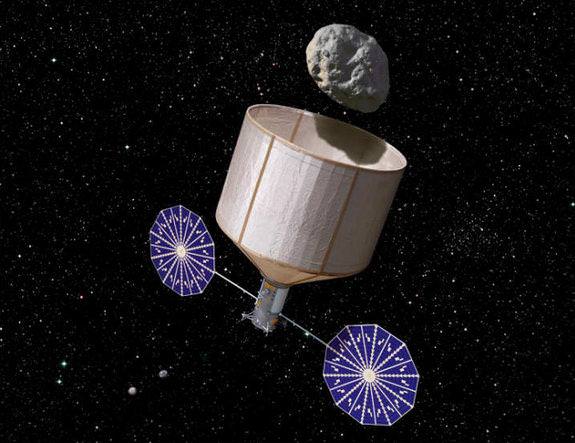
Rumors have been leaking out for over a week, but now according to Alan Boyle at NBC News’ Cosmic Log, a senior Obama administration official has confirmed that $100 million is being sought for NASA’s budget request for the coming fiscal year for work to allow a robotic spaceship to capture a small asteroid and park it near the Moon for astronauts to explore. The spacecraft would capture a 500-ton, 7- meter (25-foot) asteroid in 2019. Then using an Orion space capsule, a crew of about four astronauts would station-keep with the space rock in 2021 to allow for EVAs for exploration. This plan would accelerate NASA’s deep space missions with Orion and prepare crews for going to Mars.
NBC news quoted the official — who spoke on condition of anonymity because there was no authorization to discuss the plan publicly — as saying the mission would “accomplish the president’s challenge of sending humans to visit an asteroid by 2025 in a more cost-effective and potentially quicker time frame than under other scenarios.”
A week ago, Aviation Week reported that NASA was considering this asteroid mission, which was proposed by the Keck Institute for Space Studies last year. Keck’s proposal had a price tag of $2.6 billion, but no cost estimate for the space agency’s version has yet been released.
Then on April 5, the Associated Press quoted U.S. Sen. Bill Nelson, D-Florida, Nelson, chairman of the Senate science and space subcommittee, that President Obama is putting $100 million in planning money for the accelerated asteroid mission in the 2014 budget that comes out next week. The money would be used to find the right small asteroid.
“It really is a clever concept,” AP quoted Nelson said in a press conference in Orlando. “Go find your ideal candidate for an asteroid. Go get it robotically and bring it back.”
This would be the first time ever an object in space of this size would be manipulated in such a manner.
In depth: A Human Mission to an Asteroid: Why Should NASA Go?
Donald Yeomans, who heads NASA’s Near Earth Object program, was quoted that while there are thousands of asteroids around 25-feet, finding the right one that comes by Earth at just the right time to be captured will not be easy. And once a suitable rock is found it would be captured with the space equivalent of “a baggie with a drawstring. You bag it. You attach the solar propulsion module to de-spin it and bring it back to where you want it.”
A 7- meter (25-foot) asteroid is not a threat to Earth because asteroids of that size would burn up in Earth’s atmosphere.
The official quoted by NBC said the plan has been under discussion for months, but after February’s meteor blast over Russia, the plan gained traction. The asteroid’s entry into Earth’s atmosphere and subsequent airblast injured more than 1,000 people, and sparked discussions about asteroid threats, including a series of congressional hearings. Congressional officials said they would support more funding to counter asteroid threats.
“This plan would help us prove we’re smarter than the dinosaurs,” NBC quoted said the official, referring to the asteroid that wiped out the dinosaurs and many other species 65 million years ago.
Close Passing Asteroid 2013 ET Gets Its Picture Taken
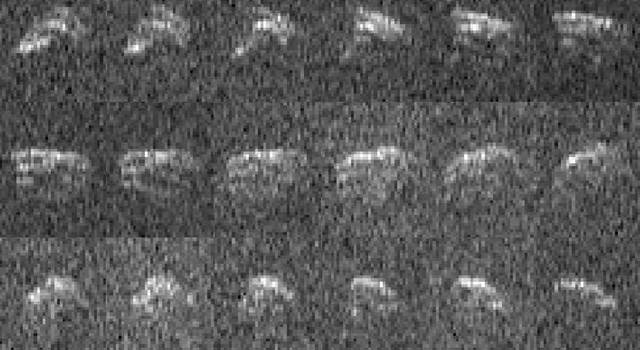
Another space rock sat pretty for NASA’s big dish photographer. The 70-meter (230-feet) Goldstone antenna zinged radio waves at 2013 ET on March 10 when the asteroid flew by Earth at 2.9 lunar distances or about 693,000 miles (1.1 million km).
By studying the returned echoes, astronomers pieced together 18 images of a rugged, irregular-shaped object about 130 feet (40 m) across. Radar measurements of an asteroid’s distance and speed nail down its orbit with great accuracy, enabling scientists to predict whether or not it might become a danger to the planet at a future date.

It’s also the only way outside of a sending a spacecraft to the object of seeing a small asteroid’s shape and surface features. Most optical telescopes cannot resolve asteroids as anything more than points of light.
By convention, radar images appear “lit” from above. That’s the side closest to the antenna. As you examine a radar image from top to bottom, distance from the antenna increases and the asteroid fades. If the equator of the asteroid faces the antenna, it will appear brightly illuminated at the top of the image. If the antenna faces one of the poles, the pole will be on top and lit up. It takes a bit of getting used to.
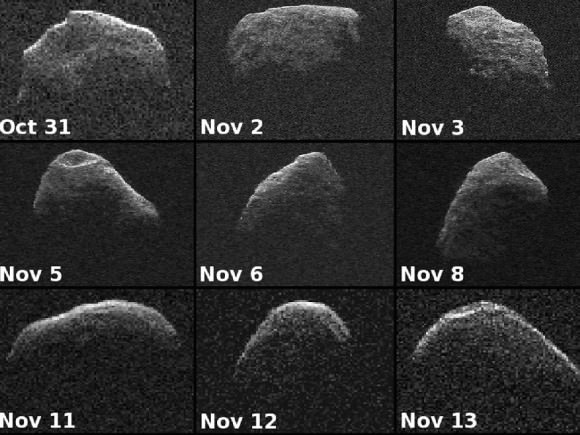
The asteroid’s width in the images depends on the asteroid’s rotation rate and the antenna’s perspective. If the antenna stares directly down over the equator and the asteroid rotates rapidly, the images will be stretched from Doppler-shifting of the returned radar echo.
Radio waves are a form of light just like the familiar colors of the rainbow. If radio light is moving toward you, its waves bunch together more tightly and appear slightly bluer than if they were at rest. Astronomers call this a Doppler shift or blueshift. If they’re moving away, the light waves get stretched and become “redshifted”.
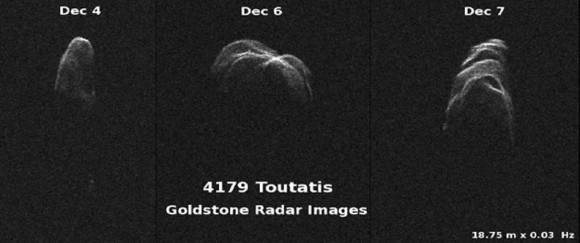
A slow-rotating asteroid will appear narrower to radar eyes, and if it doesn’t rotate at all, will show up as a “spike” of light. When the antenna happens to be point directly at a pole, the asteroid will appear to be rotating neither toward nor away from the observer and also look like a spike.
Most asteroids fall somewhere in between, and their radar portraits are close to their true shapes. Radar images show us surface textures, shape, size, rotation rate and surface features like craters. 2013 ET joins the ranks of numerous asteroids probed by radio waves from Earth as we try to grasp the complexity of our planetary neighborhood while hoping for we don’t stare down cosmic disaster anytime soon.

